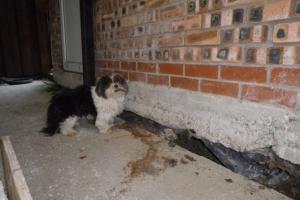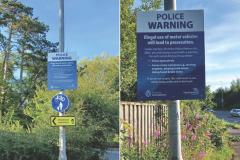
Cheshire East Council has announced that any subsidence at properties located close to Lindow Moss is not a Council matter but a civil one.
As previously reported, Saltersley Common Preservation Society contacted George Osborne in August asking once again for his assistance to stop the peat extraction at Lindow Moss, which their experts say has caused subsidence to Newgate Kennels and a number of neighbouring houses.
George Osborne told wilmslow.co.uk "Lindow Moss is an incredible piece of our natural ancient landscape, and while I completely respect that the Council has to abide by the rules, we should consider whether extracting peat is really the best use we can make of this beautiful and historic site."
As reported last week, the Tatton MP raised the matter with Cheshire East Council and received a response saying that there is no evidence of a link between the peat extraction and local subsidence.
In a letter to George Osborne, Andrew Round, Interim Executive Director, wrote "Your constituents concerns regarding the impact of this peat extraction have been noted previously, and were, as they noted in their letter to you, investigated by the Local Government Ombudsmen in 2012. As has been set out in previous correspondence, their investigation looked at a number of issues, but it was concluded that there was no evidence to back up the claims made by the complainant about land subsidence."
Mr Round continued "Since then, more information has come to light as a result of the current planning application on the site. This hydrological information has been scrutinised by the Environmental Agency and they have found no evidence of a casual link between the peat extractions activities and local subsidence issues."
I contacted Cheshire East Council earlier this month requesting a statement about the subsidence of properties neighbouring Lindow Moss, asking what CEC believes is causing the subsidence.
A spokesman for Cheshire East Council said: "The issue of any subsidence at Lindow Moss in so far as it may affect properties, is not a matter for the Council and is not one on which we would choose to comment.
"As with any evidence of subsidence, property owners should seek legal advice as this is a civil matter and one on which the Council would not comment."
However, members of Saltersley Common Preservation Society, dispute this claim saying it is 'definitely incorrect'.
Tony Evans, Secretary of Saltersley Common Preservation Society, said "The Council, as Mineral Planning Authority (MPA), is a stakeholder in the events that have, and still are, taking place on Lindow Moss. It may say that it does not wish to comment but it is burying its head in the proverbial peat! Very soon it will be forced to comment, by which time the consequences on a number of fronts will, without question, have become far worse.
"However, the Lindow Moss picture is far larger than merely looking at the subsidence, though those property owners affected may see this as the key point. The fact is that the Council has a closed mind to the physical, ecological and environmental consequences of its failure to take action. It is outside its technical comprehension and comfort zone.
"In making this statement, the history and background are important. In the second half of the last century open ended mineral planning permissions were granted by MPAs, frequently with no meaningful restoration protocol. This applied through the full range of minerals from hard rock to peat, and was clearly unfortunate, often leaving local people around sites with greatly reduced amenity and the ecology and environment under direct threat. To address this, end dates, usually circa 2042, were imposed and operators were required to review their operations and restoration proposals under a national Review of Old Mineral Permissions (ROMPS). This review gave the MPAs extensive powers, only tempered by the need to render the mineral operations viability.
"Insofar as peat extraction was concerned, the latter part of the last century had shown that peat beds provided valuable habitat, and most importantly, acted as sinks for carbon compounds. The excavation and drying out of peat deposits releases the carbon compounds and this is a key contributor to global warming. The habitats of peat sites embrace many Schedule 1 and red list birds and protected species such as as water voles and badger, as well as many rarer dragonflies and other invertebrates.
"In response to the movement to improve the environment and bio-diversity, the MPA, formerly Cheshire County Council, and now Cheshire East Council undertook a ROMP on the Lindow Moss consents, around the year 2000. This involved detailed evaluation of the peat extraction and restoration and the issue of a revised planning consent. This new consent contained 51 conditions that the owners/operators were duty bound to observe. Conditions may only be attached to a consent if they satisfy a number of tests. These are tests which are relevant to the development to be permitted and are considered enforceable, necessary, precise and reasonable in all other aspects. These conditions were not appealed and, thus, the MPA is duty bound to enforce them unless it can be demonstrated that there is no longer any need to do so. The County Councils responsibility to do this devolved to Cheshire East when the former was disbanded in 2008.
"From this point when the ROMP consent was issued in 2003, a number of key conditions were not enforced and several of these were crucial. The monitoring of the groundwater levels is crucial and this the Council's have singularly failed to do. Without this there can be no correlation of any of the events that have followed. The second is the depth of excavation of the peat and the maintenance of the integrity of the basal layers. Thirdly is the protection of the water voles and fourthly the introduction of a sluice gate to maintain water levels.
"The consequence of the lack of enforcement has had the following confirmed results. First, the water vole experts have described the site as the most comprehensively trashed they have ever seen. There is now evidence of water vole activity in a solitary ditch, from a location considered important enough to preserve in 2003. The basal layers of the peat have been compromised with the exposed sand visible from outer space. This has resulted in the creation of a sump, whereby surface water drains away almost instantaneously. The sluice to maintain water levels was never constructed, with an Officer of the Council taking the unilateral decision that it was not needed, without the necessary delegated powers or seeking any approval from the MPA.
"Finally, and crucially, the monitoring equipment has not been maintained and has been vandalised. The MPA has not, therefore, been able to receive meaningful readings as required by the ROMP consent and so the Environment Agency has not been in a position to understand what is happening to the water environment. Moreover, in a complaint to the Local Government Ombudsman in 2012, it was concluded that this amounted to maladministration and the matter needed to be addressed urgently. To date, nothing has been done to effect the necessary improvements.
"Over the last 13 years, as the peat has dried out or been extracted, the remaining peat has compressed and the surrounding ground levels have lowered by a significant amount. This has affected a number of nearby properties and insurance claims and litigation are in hand. The Council denies any causal link between the peat workings and the land subsidence. However, it is an accepted fact that wherever there are peat workings there has been ground subsidence, unless the necessary preventative and recharge protocols are employed. The Council cannot cite any workings where this has not been the case. What is true is that there has been no correlation between the reduction in groundwater levels and the land subsidence, but this is purely because the monitoring equipment has neither been maintained or meaningful readings collected.
"The local Councillors have been informed but have not pursued the Council to meet its obligations and are under serious threat of a charge of negligence and potential surcharge. It is not the Officers who are the MPA but the Members and we, the Council Tax payers, should not be faced with a bill that is likely to run into millions, merely because the Council has failed to exercise due diligence.
"The unequivocal conclusion is that the Council cannot abrogate its responsibilities by claiming the entire matter is a civil one. Where the responsible authority fails to carry out its necessary and legal obligation it becomes a major contributor to the cause, and is, therefore, liable, either jointly or severally with the operator. However, it is worth remembering that had the Council's not allowed the operator to work in an unacceptable manner and overseen the ROMP consent the dire consequences for the habitat and the surrounding land would not have occurred.
"Even if the Council believes it does not need to engage today with the ongoing claims and litigation arising from the dewatering and settlement, it is failing in its legal and moral obligations to safeguard our future in terms of ongoing harm to bio-diversity and global warming.
"Importantly, a new ROMP is due in 2018 when all these concerns and questions will again be raised and answers sought. Even today, we have proposals for at least two housing schemes within the drawdown area of the peat workings, and who in their right mind is likely to purchase a home on a sinking site?"
Planning permission for peat extraction on Lindow Moss was granted by five separate permissions between 1959 and 1967, these expire in February 2042.
Croghan Peat Industries Ltd of Meare in Somerset purchased Lindow Moss in 1997-8 and in December 2014 they submitted two planning applications, to build 14 detached houses on part of Lindow Moss and restore the 28 hectare peat extraction site to a natural wetland habitat.
The owners are proposing to cease peat extraction if planning permission for the houses is granted however the two applications, which were expected to be decided in March and April 2015, have been delayed for nearly 18 months due to ongoing discussions with expert bodies.
A Council spokesman told wilmslow.co.uk last month "There are ongoing discussions with expert bodies such as Natural England and the Cheshire Wildlife Trust to examine the details of the restoration scheme and its future management which must be completed before any conclusions can be reached regarding the acceptability or otherwise of these proposals."









Comments
Here's what readers have had to say so far. Why not add your thoughts below.
Having read the article would you trust the Council or Croghan Peat?
Caveat emptor
Gerard Lee
Further more, in recent months I have noticed signs of the land sinking further and further away from the excavation site. It is quite clear that the land on both sides or Rotherwood Road is affected, but I have noticed changes to land much nearer to Moor Lane, Arlington Crescent and Burford Crescent.
Left unchecked the total bill for rectifying the damage will run into millions. How long do we have to wait for Cheshire East to step in and try to reduce the damage by implementing the planning conditions and mainly enforcing the construction of the sluice gate.
Just a thought!
We would also like to point out that continual remedial work is being carried out to make the kennels safe and open for business.